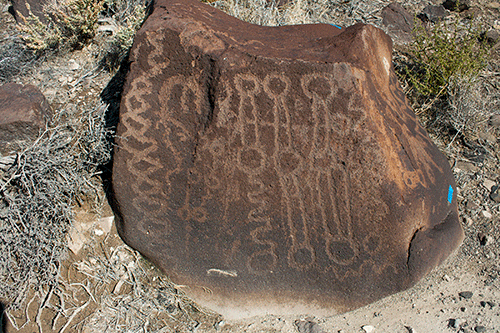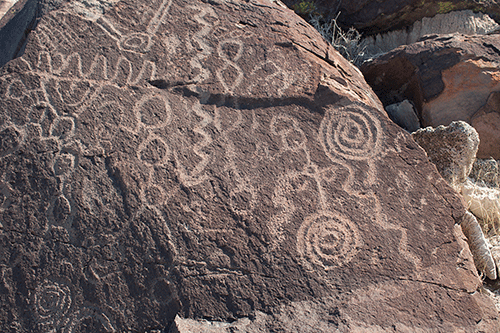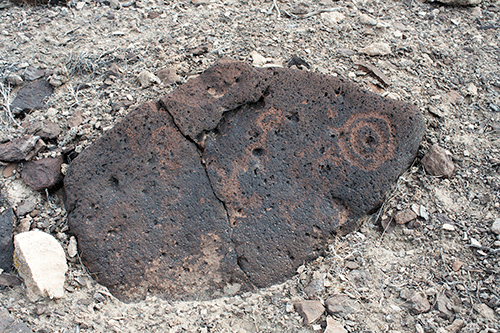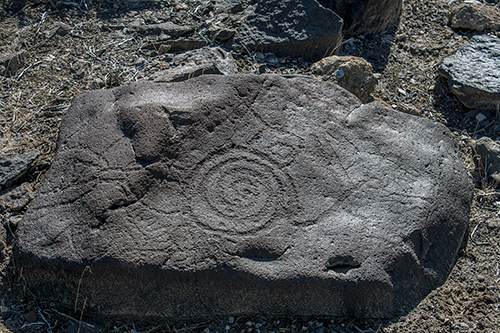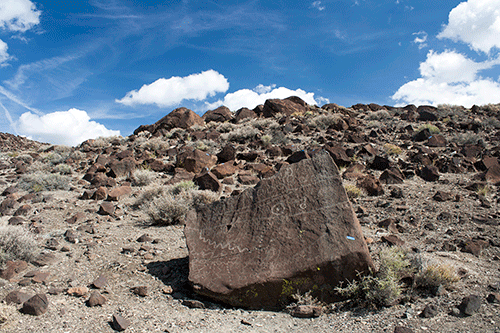Lahontan Reservoir
During fall 2014, NRAF staff and volunteers conducted fieldwork at the Lahontan Reservoir Petroglyph Site in Lyon County. The site is in Lahontan State Recreation Area, managed by Nevada Division of State Parks whose staff provided invaluable logistical support. The site is located above the shoreline of a reservoir constructed in 1915 as part of the Newlands Reclamation Project. Tufa deposits at the site indicate that the area would have been deeply submerged by Pleistocene Lake Lahontan, which covered much of northwestern Nevada during the Ice Age. By 9,000 years ago, the lake had largely dried up, leaving behind playas and marshes. The earliest hunter-foragers in the region appear to have favored lakeside marshes and other wetlands for their settlement activities. However, it is more likely that the Lahontan Reservoir Petroglyph site was made and used around 4,000-1,500 years ago based on the area’s general settlement and environmental history.
Early Euro-American settlers apparently knew of the site as the “Mountain of Hieroglyphics” (M. Angel, 1881, History of Nevada) but, until the 1950s, archaeologists had difficulty in relocating the site, believing that the site was submerged by the waters of the reservoir. Archaeological investigations at the site prior to NRAF’s work have been preliminary enquiries that recommended more intensive fieldwork to describe its characteristics. Accordingly, NRAF’s recordation project sought to intensively record the rock art and archaeology of this large, but inadequately known site.
The Lahontan Reservoir Petroglyph Site covers an area of approximately 5.5 acres, overlooking what would have been a productive marsh environment at various times over the past 4,500 years. Survey revealed the site to be one of the larger petroglyph sites in northwestern Nevada, comprising 208 rock art boulders densely distributed in two main concentrations. Other prehistoric archaeological features are surprisingly slight; just two mortars, a grinding slick, and a few waste flakes. This suggests short-term and small-scale residential use of the site, indicating that the site was primarily visited from nearby temporary campsites. It also may suggest that the focus of site visits was the rock art. Rock art is dominated by abstract designs with a heavy emphasis on curvilinear motif types. Representational imagery is notably rare with stick-figure anthropomorphs and zoomorphs almost entirely absent. This pronounced emphasis on abstract designs seems to be a regional feature of the northwestern Nevada rock art record. The site’s curvilinear imagery is notable for including novel and highly formal large designs. Discernible differences in the appearance of the surface patination of rock art motifs at the site suggest that there may be temporal differences the sequence of rock art production. Further analysis could contribute information that helps clarify the relative sequence of stylistic evolution in Great Basin rock art.
Acknowledgements—This project was made possible with the assistance of the Nevada State Historic Preservation Office through a US Department of Interior Grant. Anthony Beauregard, Park Supervisor, and the staff of Lahontan State Recreation Area provided enthusiastic support and logistical help during the project. The hard work of volunteers Wendy Antibus, Carolyn Barnes-Wolfe, Ralph Bennett, Anne Higgins, Janice Hoke, Joan Johnson, Sue Ann Monteleone, Robert Stolting, Don Wescott, and Fred & Sandy Zoerner, is gratefully acknowledged.


